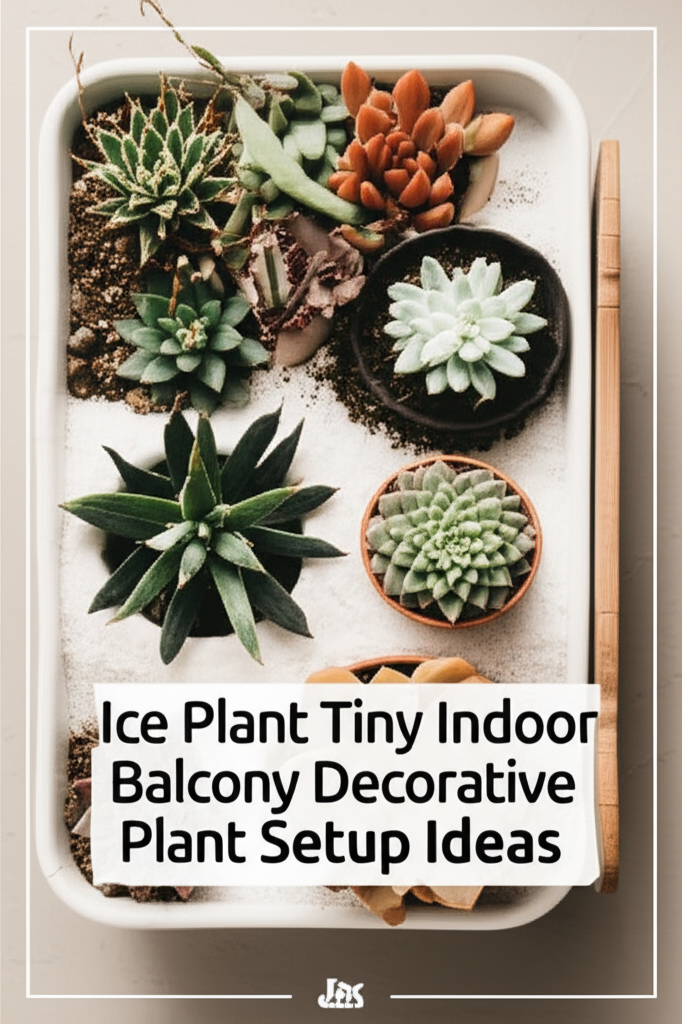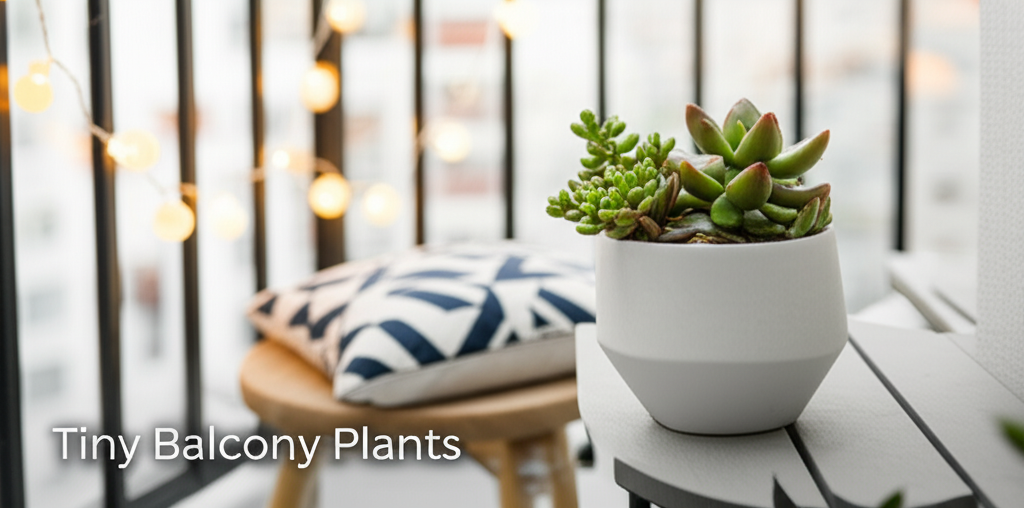Unlocking the Charm: Why Ice Plants Thrive on Tiny Balconies
Bringing a touch of the desert to your urban retreat is a dream for many, and the ice plant succulent (often belonging to the Delosperma genus) makes this a surprisingly achievable reality, especially on compact indoor balconies. These resilient beauties, characterized by their glistening, jewel-like epidermal cells that resemble tiny water droplets, offer a unique visual appeal and are remarkably forgiving for beginner plant enthusiasts. Their compact growth habit and drought tolerance make them perfectly suited for the often-limited space and fluctuating conditions of an indoor balcony environment.
The “ice” effect, which gives them their common name, is a fascinating adaptation. These specialized cells, called idioblasts, are filled with water and help the plant to absorb moisture from the air, reflect excess sunlight, and protect it from harsh elements. This natural resilience translates into a low-maintenance companion that can bring vibrant color and texture to even the smallest of spaces. From sun-drenched windowsills to the edges of your balcony railing, ice plants can transform overlooked nooks into miniature ecosystems of captivating beauty.
Understanding the Ice Plant: A Succulent Superstar
Before diving into setup ideas, it’s crucial to understand the fundamental needs of these captivating succulents. Ice plants, in their natural habitat, are typically found in arid and semi-arid regions, often in rocky or sandy soils. This tells us a lot about their preferred growing conditions:
- Sunlight: Ice plants are sun-worshippers. They require at least 6-8 hours of direct sunlight per day to thrive and produce their abundant, daisy-like blooms. On an indoor balcony, this often means positioning them in the sunniest spots, such as south-facing windows or areas that receive morning and afternoon sun.
- Soil: Excellent drainage is paramount. They despise soggy roots, which can lead to rot. A well-draining succulent or cactus mix is ideal. You can also create your own by combining potting soil with perlite, pumice, or coarse sand.
- Watering: This is where the “low-maintenance” aspect truly shines. Ice plants are drought-tolerant. It’s far better to underwater than overwater. Allow the soil to dry out completely between waterings. The frequency will depend on your balcony’s temperature, humidity, and the amount of sunlight the plant receives.
- Temperature: While hardy, most Delosperma species prefer moderate temperatures. They can tolerate heat well but may struggle with prolonged periods of frost. Indoor balconies offer a more stable environment, protecting them from extreme temperature fluctuations.
- Potting: Terracotta pots are excellent choices for ice plants due to their porous nature, which aids in soil aeration and allows excess moisture to evaporate. However, any pot with adequate drainage holes will suffice.
Key Facts and Comparison: Ice Plants vs. Other Balcony Succulents
To truly appreciate the suitability of ice plants for tiny indoor balconies, let’s compare them to a few other popular succulent choices for similar environments.
| Feature | Ice Plant (Delosperma) | Echeveria | Sedum (Stonecrop) | Haworthia |
|---|---|---|---|---|
| Sunlight Needs | High (6-8+ hours direct) | High (6+ hours direct) | High (4-6+ hours direct) | Medium to Bright Indirect |
| Watering Needs | Low (allow to dry completely) | Low (allow to dry completely) | Low (allow to dry completely) | Low to Medium (allow to dry partially) |
| Drought Tolerance | Excellent | Excellent | Excellent | Good |
| Bloom Potential | High (vibrant, daisy-like flowers) | Moderate (spikes of colorful flowers) | High (clusters of star-shaped flowers) | Low (inconspicuous flowers) |
| Growth Habit | Spreading, trailing, or low-growing | Rosette-forming | Upright, trailing, or groundcover | Clumping, rosette-forming |
| Best for Small Spaces? | Yes, especially trailing varieties | Yes, attractive rosettes | Yes, compact varieties available | Yes, compact and attractive foliage |
As you can see, ice plants hold their own, offering a unique combination of vibrant flowering, adaptable growth habits, and excellent drought tolerance, making them a compelling choice for any balcony gardener.
Tiny Balcony Setup Ideas: Maximizing Your Ice Plant Potential

The beauty of ice plants lies in their versatility and how effortlessly they can elevate a small space. Here are some creative and practical setup ideas for your indoor balcony:
Idea 1: The Miniature Desert Landscape
Create a cohesive miniature desert scene by grouping several ice plants in different pots, interspersed with decorative elements.
- Containers: Opt for a mix of small terracotta pots, ceramic planters with drainage holes, or even repurposed containers like old teacups or mason jars (ensure drainage!).
- Plant Selection: Choose a few different varieties of ice plants with varying flower colors and growth habits. Some Delosperma species are more upright, while others are excellent trailers.
- Decorative Elements: Incorporate small pieces of driftwood, attractive pebbles, colorful gravel, or miniature desert-themed figurines to enhance the visual appeal.
- Placement: Arrange these groupings on a small shelf, a windowsill, or clustered together on the balcony floor.
Idea 2: Hanging Jewel Cascades
Harness the trailing nature of some ice plant varieties by showcasing them in hanging baskets.
- Containers: Choose shallow, wide hanging baskets or macrame plant hangers. The extra surface area allows the trailing stems to cascade freely.
- Plant Selection: Focus on trailing ice plant varieties like Delosperma cooperi or those specifically bred for their cascading habit.
- Soil: Use a very well-draining succulent mix, as hanging baskets can dry out more quickly, but you still want to avoid waterlogging.
- Placement: Hang these baskets from the balcony ceiling or railing to add vertical interest and a waterfall of color.
Idea 3: Vertical Garden with a Twist
Utilize vertical space with a tiered planter or a wall-mounted succulent holder.
- Containers: Consider a small tiered planter designed for succulents or a modular wall-mounted system.
- Plant Selection: Mix ice plants with other succulents that have similar light and watering needs, such as Echeverias or Sempervivums, to create a diverse vertical display.
- Arrangement: Place the ice plants strategically where they can receive ample sunlight, perhaps in the upper tiers or front-facing pockets.
- Maintenance: Ensure easy access for watering and to remove any dead foliage.
Idea 4: The Solo Statement Piece
Sometimes, a single, striking ice plant can be the star of your balcony.
- Container: Choose a beautiful, well-designed pot that complements the plant’s aesthetic, perhaps a glazed ceramic pot or a distinctive terracotta planter.
- Plant Selection: Select a particularly healthy and robust ice plant, or one with a unique bloom color.
- Placement: Position this solo specimen in a prime location where it will be the focal point, perhaps on a small side table or at the entrance to your balcony.
Idea 5: Integrated into a Larger Display
If you have other plants on your balcony, ice plants can be excellent companions, adding pops of color and texture.
- Companion Plants: Pair them with other drought-tolerant plants like herbs (rosemary, thyme) or other succulents that enjoy similar conditions.
- Placement: Nestled amongst larger plants or at the front of larger pots, ice plants can fill in gaps and provide continuous visual interest.
- Considerations: Ensure that the watering needs of all plants in close proximity are compatible.
Caring for Your Ice Plant Balcony Setup: Essential Tips and Techniques
Once your ice plant setup is complete, consistent care will ensure your miniature oasis flourishes.
Step-by-Step Care Guide
Caring for ice plants on an indoor balcony is straightforward if you remember their core needs.
| Step | Action | Considerations for Balcony Setup |
|---|---|---|
| 1. Watering | Water thoroughly only when the soil is completely dry to the touch. | Check soil moisture frequently, especially during warmer months or if the balcony is very sunny. Err on the side of underwatering. |
| 2. Sunlight | Provide at least 6-8 hours of direct sunlight daily. | Rotate pots periodically to ensure even growth and flowering, especially if sunlight is directional. |
| 3. Soil & Drainage | Use a fast-draining succulent mix. Ensure pots have drainage holes. | Avoid letting pots sit in saucers of water. Consider elevating pots slightly if drainage is a concern. |
| 4. Fertilizing | Feed sparingly during the growing season (spring/summer) with a diluted succulent fertilizer. | Over-fertilizing can lead to weak growth and fewer blooms. |
| 5. Pruning & Deadheading | Trim leggy growth to encourage bushier plants. Remove spent flowers. | Pruning can also help maintain the desired shape for your display. |
| 6. Pest Control | Watch for common succulent pests like mealybugs and spider mites. | Treat infestations promptly with insecticidal soap or neem oil. Good airflow helps prevent pests. |
Pros and Cons of Ice Plants on Indoor Balconies
Like any plant, ice plants have their advantages and disadvantages when grown in this specific environment.
Pros:
- Vibrant Blooms: They offer a spectacular display of colorful, daisy-like flowers, often for extended periods.
- Drought Tolerance: Excellent for busy individuals or those prone to forgetting to water.
- Low Maintenance: Generally pest-resistant and require minimal fuss.
- Compact Growth: Many varieties are naturally compact or trailing, perfect for small spaces.
- Unique Texture: The “ice” cells provide a fascinating visual and textural element.
- Sun-Loving: Ideal for sunny balconies that may be too hot for other plants.
Cons:
- High Light Requirement: Insufficient sunlight will result in leggy growth and no blooms.
- Overwatering Susceptibility: Can be prone to root rot if not allowed to dry out between waterings.
- Frost Sensitivity: While adaptable, prolonged freezing temperatures can damage or kill the plant. Indoor balconies offer protection, but extreme cold snaps may still pose a risk if not adequately sheltered.
- Spreading Nature: Some varieties can spread quite vigorously, which might require occasional pruning to keep them contained in small pots.
Troubleshooting Common Issues for Balcony Ice Plants
Even with their resilience, you might encounter a few minor issues with your balcony ice plants.
Yellowing Leaves:
This is almost always a sign of overwatering. Ensure the soil is drying out completely between waterings. If the soil is constantly wet, you may need to repot into drier soil and check for root rot.
Leggy Growth and No Blooms:
This indicates insufficient sunlight. Move the plant to a sunnier location. If your balcony doesn’t receive enough direct sun, consider supplemental grow lights.
Mushy or Soft Stems:
This is a classic symptom of overwatering and potential root rot. Act quickly: remove the plant from its pot, trim away any mushy roots, and repot in dry, well-draining soil. Allow the plant to recover before watering again.
Pests (Mealybugs, Spider Mites):
Inspect your plants regularly. If you spot pests, isolate the affected plant and treat with a cotton swab dipped in rubbing alcohol for spot treatment, or use insecticidal soap or neem oil for more widespread infestations. Good airflow and healthy plants are the best defense.
Conclusion: Your Tiny Balcony, Transformed by Ice Plant Beauty
The ice plant succulent is a true gem for any indoor balcony gardener seeking to infuse their small space with color, texture, and resilience. With their captivating “icy” appearance, vibrant blooms, and undemanding nature, they offer a rewarding gardening experience. By understanding their basic needs and employing some creative setup ideas, you can transform your tiny balcony into a miniature desert oasis, a personal sanctuary that brings a touch of the wild and a splash of perpetual sunshine into your urban dwelling. Experiment with different arrangements, enjoy the process, and let these remarkable succulents work their magic.


